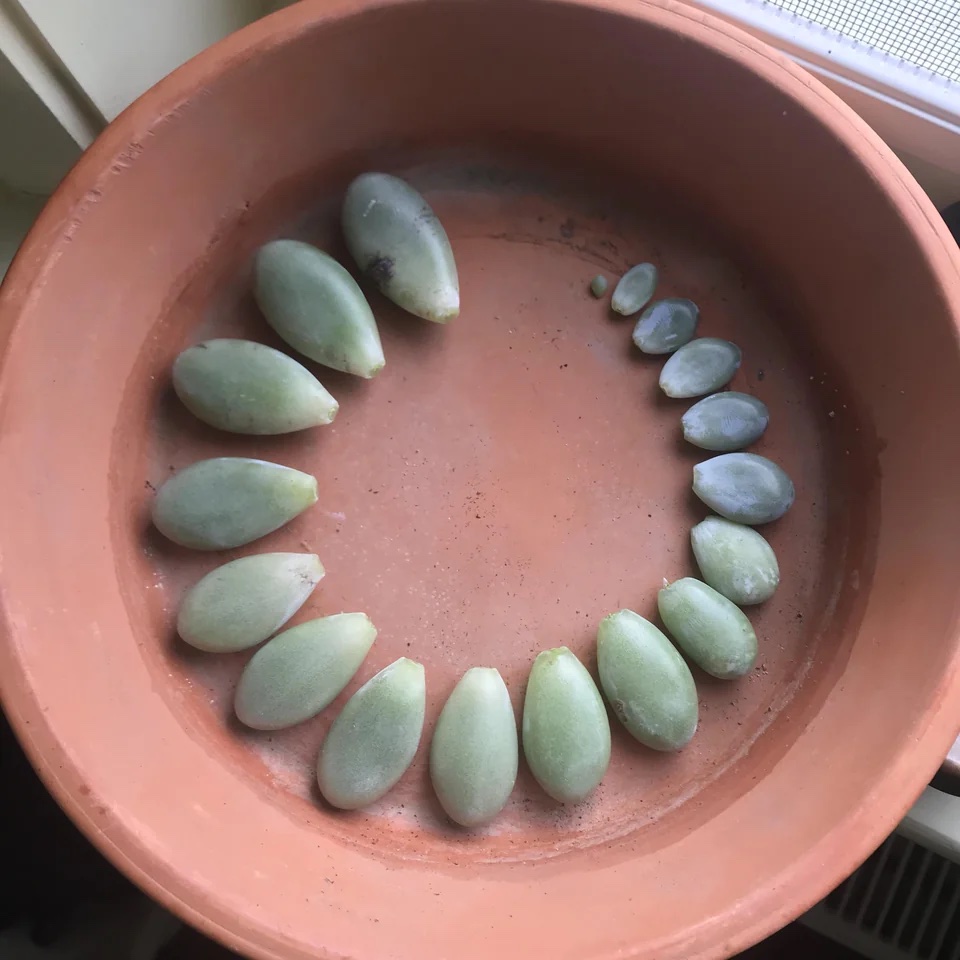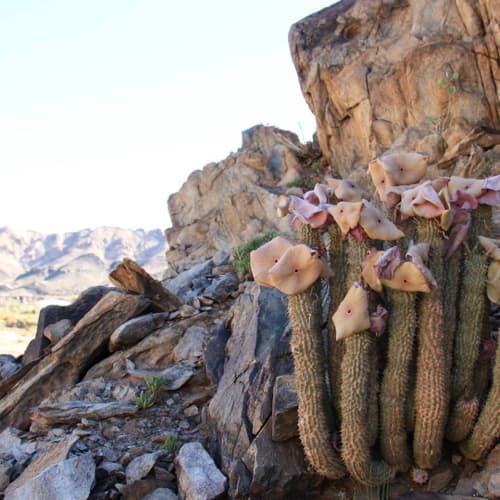Pachyphytum Oviferum (Moonstone)
Posted by Grace on February 16, 2023
Pachyphytum oviferum is a species of succulent plant that belongs to the family Crassulaceae. It is commonly known as "Moonstones" or "Sugar Almonds" due to its unique shape and appearance.
Its leaves are fleshy, gray-green, and arranged in a rosette pattern. The leaves are round and plump, giving the plant a unique appearance that resembles a cluster of tiny eggs or sugar almonds. The edges of the leaves have a slight pinkish tint that adds to the plant's charm.
Pachyphytum oviferum is commonly found in blue, while the pink variant is much rarer (also called Pachyphytum oviferum Roseum, or Pink Moonstone), albeit very attractive.
 Pink Moonstone Succulent (Source)
Pink Moonstone Succulent (Source)
Contents
Quick Facts
- Native Habitat: Mexico 🇲🇽, in the rocky cliffs of the state of San Luis Potosi at 1200 meters altitude
- Family: Pachyphytum (small genus), Crassulaceae (larger genus)
- Water: Wait until the soil has completely dried out before watering again
- Sunlight: Full Sun to Partial Shade
- Soil: Well-draining
Why it is called Pachyphytum oviferum?
The name "Pachyphytum oviferum" is derived from the Greek words "pachys", meaning thick, and "phyton", meaning plant, which refers to the plant's thick leaves. The species name "oviferum" is derived from the Latin word "ovum", meaning egg, which refers to the shape of the plant's leaves, which resemble small eggs or almonds.
 The Blue Pachyphytum Oviferum (Blue Moonstone) that I got from Trader Joe's
The Blue Pachyphytum Oviferum (Blue Moonstone) that I got from Trader Joe's
 Pachyphytum Oviferum Variegated (Source)
Pachyphytum Oviferum Variegated (Source)
Propagation of Moonstone
Pachyphytum Oviferum can be easily propagated by removing offsets or by leaf cuttings.
Propagating Moonstone with Offsets
Propagating Moonstone with offsets is a relatively simple process that involves separating the small plantlets or offsets that grow from the mother plant and planting them in a new location. Here are the steps to propagate moonstone with offsets:
-
Find a healthy and mature moonstone plant with offsets. Moonstone plants typically produce offsets around the base of the mother plant. These offsets should be about a third to half the size of the mother plant, and should have their own roots and leaves.
-
Prepare a new container. Choose a pot that is slightly larger than the offset you are propagating, and ensure that it has drainage holes. Fill the container with a well-draining potting mix, such as cactus or succulent soil.
-
Carefully remove the offset from the mother plant. Use a sharp, clean knife or garden shears to cut the offset from the base of the mother plant. Make sure to avoid damaging the roots or leaves of either plant.
-
Allow the offset to callus over. Place the offset in a cool, dry place for a few days to allow the cut edge to dry out and form a callus. This will help prevent rot and infection when you plant the offset.
-
Plant the offset in the new container. Once the cut has formed a callus, plant the offset in the prepared container, burying the roots in the soil and gently pressing the soil down around the base of the plant. Water the offset sparingly at first to avoid overwatering, and gradually increase the amount of water as the plant establishes itself.
-
Provide the new plant with the proper care. Moonstone plants prefer bright, indirect light and well-draining soil. Water the plant when the soil is completely dry, and fertilize it sparingly with a balanced houseplant fertilizer during the growing season. Over time, the offset will grow into a mature moonstone plant of its own.
Propagating Moonstone with Leaf Cuttings
Propagating moonstone with leaf cuttings is a simple and effective method that involves taking a healthy leaf cutting from a mature plant and rooting it in soil. Here are the steps to propagate moonstone with leaf cuttings:
-
Choose a healthy and mature moonstone plant. Select a plant that has healthy leaves with no signs of damage or disease. Moonstone plants with plump leaves are the best candidates for leaf propagation. Carefully remove a leaf from the plant. Use a clean, sharp knife or garden shears to cut a leaf from the plant, making sure to include the stem.
-
Allow the leaf to dry out for a few days. Place the leaf in a cool, dry place and allow it to dry out and form a callus for a few days. This will help prevent rot and infection when you plant the leaf. Prepare a container. Choose a small pot or container and fill it with a well-draining potting mix, such as cactus or succulent soil.
-
Plant the leaf cutting in the container. Make a small hole in the soil and gently insert the stem of the leaf into the soil, making sure that the callused end is in contact with the soil. Press the soil down around the base of the leaf to stabilize it.
-
Water the cutting sparingly. Water the cutting sparingly at first to avoid overwatering. Water only when the soil is completely dry, and gradually increase the amount of water as the cutting establishes itself.
-
Provide the new plant with proper care. Moonstone plants prefer bright, indirect light and well-draining soil. Water the plant when the soil is completely dry, and fertilize it sparingly with a balanced houseplant fertilizer during the growing season. Over time, the cutting will grow into a mature moonstone plant of its own.
Note that it may take several weeks or even months for the cutting to take root and produce new growth. Be patient and keep the soil moist but not wet, and eventually, you should see new growth emerging from the base of the leaf.
 Leave moonstone leaves to dry and callus over (Source)
Leave moonstone leaves to dry and callus over (Source)
 A moonstone leave has rooted (Source)
A moonstone leave has rooted (Source)
 Moonstone props (Source)
Moonstone props (Source)
I do not water my plant until either the mother leaf begins to shrivel or the leaves of the propagules start to look dehydrated, whichever comes first.
Moonstones are so slow but the result is so worth it.
In the spring, Pachyphytum oviferum produces small, star-shaped flowers that are pink or white in color. The flowers are held on long stalks that rise above the leaves.
 Pachyphytum Oviferum flowers (Source)
Pachyphytum Oviferum flowers (Source)
Where can I get Pachyphytum Oviferum?
I was fortunate enough to obtain a few pots of Pachyphytum oviferum from the grocery store Trader Joe's.
It is also possible to purchase this plant from online stores like Mountain Crest Gardens or from sellers on Amazon, such as CTS Air Plants, who offer varieties such as the Roseum or Moonstone succulent.






